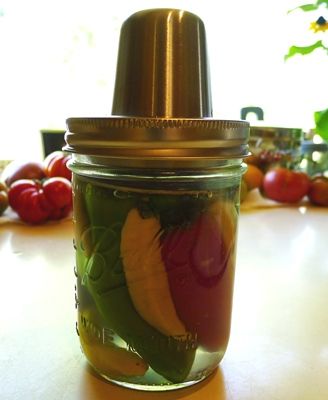
I’m a big fan of small-batch preserving because it makes the most use of my time and the fruits and vegetables I harvest from my garden during the season. Instead of marathon canning sessions, I preserve tomatoes, peppers and zucchini in mini sessions as fruits ripen.
That’s why I wanted to try my hand at fermenting in small batches, too. I like sauerkraut, but it would take ages to eat an entire crock of kraut.
Instead of fermenting large amounts, the Kraut Source is a pint-sized DIY fermenting kit. The cap, moat, spring and press fit on a wide-mouth pint mason jar for fermenting fruits and vegetables in smaller-sized batches. The kit also fits on quart and gallon jars.
I decided to give Kraut Source a try with a mixture of homegrown sweet peppers and hot chile peppers. The recipe booklet gives directions for using 1/2 cup filtered water, sea salt, peppers and a few cloves of garlic.
Even though the recipe is simple, the actual fermenting process is complicated. It’s a biochemical transformation that results in a jar of cultured “superfoods” created by lacto-fermentation.
“Lacto-fermentation means the vegetables or fruits have been fortified by lactic acid, a compound produced during the fermentation period,” according to experts at Kraut Source.
Fermented foods are good for us because they increase the digestibility of vitamins and minerals and add fiber to our diets. They’re also known as a source of beneficial bacterial that compete with harmful stomach bacteria for better health.
The keys to good fermentation include the quality of the water, the salt and, of course, the ingredients. Filtered water is best, but regular water brought to a boil and allowed to cool works just as well.
Another key is to make sure the vegetables remain submerged in the brine as they ferment. The Kraut Source uses a spring press to keep vegetables under the liquid and uses a water moat in the cap that keeps air out but allows fermentation gases to escape.
My small batch of fermented peppers should be ready in about 14 days. By then, more peppers will be ready to pack into a pint jar for preserving.
Fine Gardening Recommended Products

A.M. Leonard Deluxe Soil Knife & Leather Sheath Combo
Fine Gardening receives a commission for items purchased through links on this site, including Amazon Associates and other affiliate advertising programs.




















Comments
Log in or create an account to post a comment.
Sign up Log in